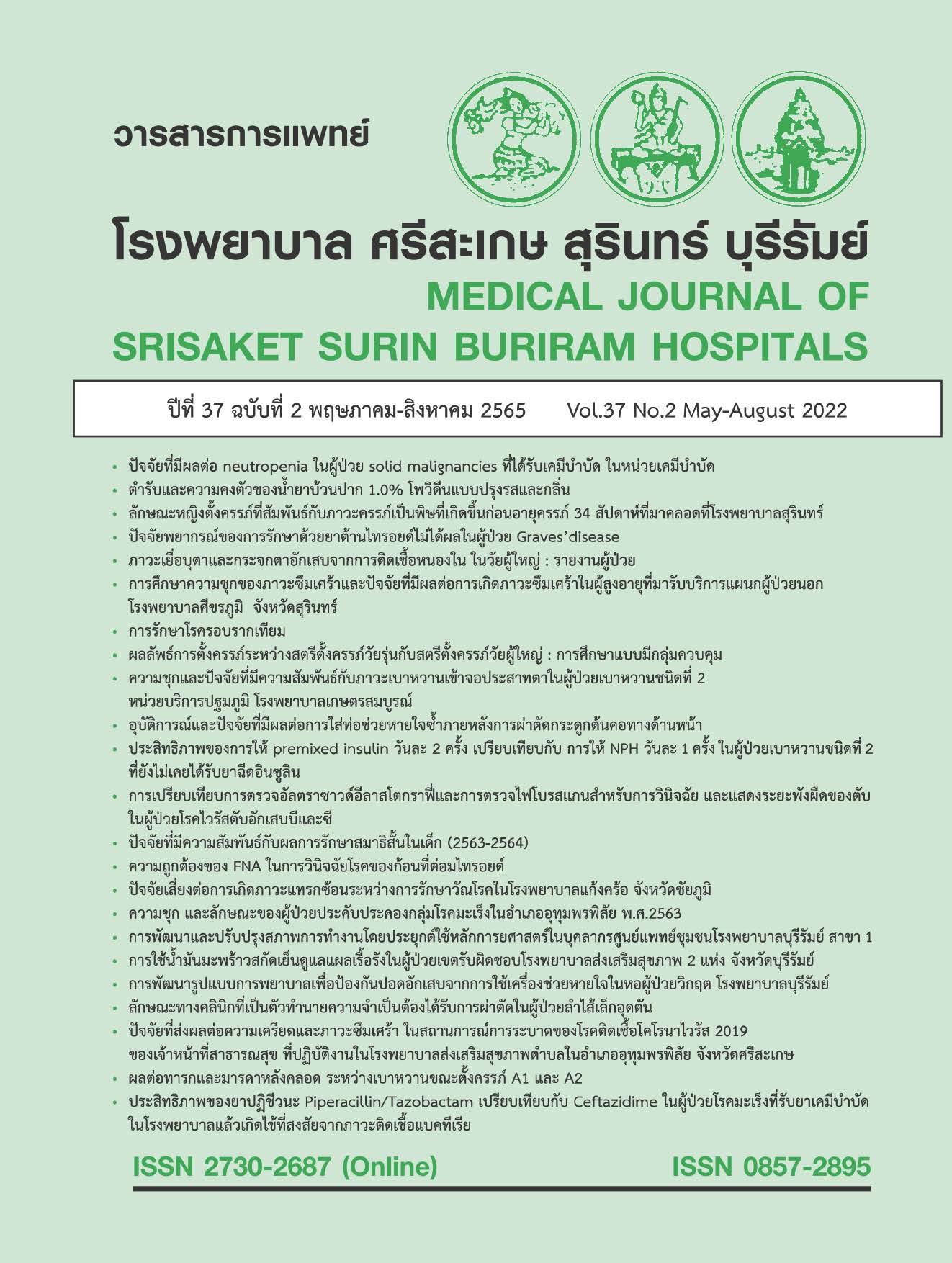Neonatal and Maternal Postpartum Outcomes Between Gestational Diabetes Mellitus A1 and A2
Main Article Content
Abstract
Background: Gestational diabetes mellitus is an medical complication that affects both fetuses and pregnant women. While gestational diabetes mellitus A1 (GDMA1) is diet-controlled, patients with GDMA2 require insulin treatment. From literature review, there was no previous study on the differences in neonatal and maternal postpartum outcomes between these two types of gestational diabetes mellitus (Buri Ram populations). Thus, the researchers were interested in comparing the postpartum outcomes of childbirth in order to document the consequences of both types of the condition and utilize the results in the care of patients with gestational diabetes mellitus.
Objectives: To compare neonatal and maternal postpartum outcomes among the patients with GDMA1 and GDMA2 giving birth at Buri Ram Hospital.
Methods: This study is a prognostic outcome research with retrospective observational design. The study data were collected from pregnant patients with GDMA1 and GDMA2 who gave birth at Buri Ram Hospital’s labor room during October 2018 - September 2020. Medical records of pregnant patients with GDMA1 and GDMA2 were reviewed for their pregnancy outcomes. Differences in neonatal and maternal postpartum outcomes between the two groups were analyzed using multivariable Gaussian regression and logistic regression by adjusting the influence of confounding risk factors.
Results: There were 267 patients in the GDMA1 cohort and 160 in the GDMA2 cohort. Age between 25-39 years. After adjusting the influence of various risk factors, it was found that the fetal birth weight in the GDMA2 patients was higher than the fetal birth weight in the GDMA1 patients with statistical significance. Fetuses born to GDMA2 patients also had an increased chance of being large-for-gestational-age (LGA) and macrosomia newborns when compared to fetuses born to patients with GDMA1 at the rate of 5 and 6 times respectively. Other secondary outcomes, such as preterm birth, preeclampsia, cesarean delivery, and neonatal hypoglycemia, were also significantly higher among the GDMA2 patients.
Conclusion: Gestational diabetes mellitus can have effects on both the fetus and the mother, especially the development of LGA newborns. Therefore, at-risk pregnant women should be screened for gestational diabetes mellitus in order to ensure appropriate care and advice, as well as to prevent neonatal and maternal complications during pregnancy, intrapartum, and postpartum period.
Article Details

This work is licensed under a Creative Commons Attribution-NonCommercial-NoDerivatives 4.0 International License.
References
The American College of Obstetricians and Gynecologists, Women’s Health care. Practice Bulletin No. 137: Gestational diabetes mellitus. Obstet Gynecol 2013;122(2 Pt 1):406-16. doi: 10.1097/01.AOG.0000433006.09219.f1.
Cunningham FG, Leveno KJ, Bloom SL, Dashe JS, Hoffman BL, Casey BM, Spong CY. Williams Obstetrics 25th ed. United States of America: McGraw-Hill Education; 2018.
The American College of Obstetricians and Gynecologists, Women’s Health care. ACOG technical bulletin, Diabetes and pregnancy, Number 200-December 1994 (Replaces No. 92, May 1986). Committee on Technical Bulletins of the American College of Obstetricians and Gynecologists. Int J Gynaecol Obstet 1995;48(3):331-9.
ชญาดา เนตร์กระจ่าง. การเสริมสร้างความเข้มแข็งในการจัดการภาวะเบาหวานของหญิงตั้งครรภ์. วารสารศูนย์การศึกษาแพทยศาสตร์คลินิกโรงพยาบาลพระปกเกล้า 2562;32(2):168-77.
Guariguata L, Linnenkamp U, Beagley J, Whiting DR, Cho NH. Global estimates of the prevalence of hyperglycaemia in pregnancy. Diabetes Res Clin Pract 2014;103(2):176-85. doi: 10.1016/j.diabres.2013.11.003.
มาสินี ไพบูลย์, จำรัส วงศ์คำ. การตรวจวินิจฉัยโรคเบาหวานขณะตั้งครรภ์ ในโรงพยาบาลศรีนครินทร์. ศรีนครินทร์เวชสาร 2552;24(3):186-9.
Yensri K, Panburana P, Israngura Na Ayudhya N, untnarumit. The Comparative Study of The Large for Gestational Age Prevalence in Neonate of Diabetic Pregnant Women Between The Optimal and Suboptimal Glycemic Control Groups . Thai J Obstet Gynaecol 2014;22(2):74-80.
Boulvain M, Irion O, Dowswell T, Thornton JG. Induction of labour at or near term for suspected fetal macrosomia. Cochrane Database Syst Rev 2016;2016(5):CD000938. doi: 10.1002/14651858.CD000938.pub2.
Saldana TM, Siega-Riz AM, Adair LS, Suchindran C. The relationship between pregnancy weight gain and glucose tolerance status among black and white women in central North Carolina. Am J Obstet Gynecol 2006;195(6):1629-35. doi: 10.1016/j.ajog.2006.05.017.
Lucas MJ, Lowe TW, Bowe L, McIntire DD. Class A1 gestational diabetes: a meaningful diagnosis? Obstet Gynecol 1993;82(2):260-5.
สมชาย ธนวัฒนาเจริญ. โรคเบาหวานในสตรีตั้งครรภ์. จุฬาปริทัศน์ กรุงเทพฯ: โรงพิมพ์แห่งจุฬาลงกรณ์มหาวิทยาลัย; 2561: 421-22.
Johnstone FD, Prescott RJ, Steel JM, Mao JH, Chambers S, Muir N. Clinical and ultrasound prediction of macrosomia in diabetic pregnancy. Br J Obstet Gynaecol 1996;103(8):747-54. doi: 10.1111/j.1471-0528.1996.tb09868.x.
Perry SE, Hockenberry MJ, Lowdermilk DL, Wilson D, Alden KR, Cashion MC. Maternal Child Nursing Care, 6th. ed. St. Louis: Mosby; 2018.
Blackburn ST. Maternal, fetal, & neonatal physiology: A clinical perspective . 3rd. ed. St. Louis: Saunders; 2007.

